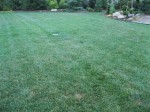 A well grown lawn is a beautiful thing and the result of many choices and much labor and one of the jobs that may be needed to keep a lawn looking its best is coring, also known as aerating. Coring is the removal of small cores of soil from the top few inches of turf. The process leaves small holes in the soil that facilitate aeration and the entrance of water and nutrients.
A well grown lawn is a beautiful thing and the result of many choices and much labor and one of the jobs that may be needed to keep a lawn looking its best is coring, also known as aerating. Coring is the removal of small cores of soil from the top few inches of turf. The process leaves small holes in the soil that facilitate aeration and the entrance of water and nutrients.
Why is this process necessary? Over time the soil in the lawn becomes compacted. People walk on the grass, kids play on it, rain falls on it, and someone regularly mows it. All these activities compact the soil, making it difficult for water, nutrients, and air to reach the roots of the grass and the growth of the grass slowly declines while the growth of weeds may increase. The problem is especially significant in clay soil where the soil is can form a hard layer.
By alleviating compaction, coring improves the entrance of water, fertilizer, and oxygen into the root zone. This increases vigor and the growth rate of the grass. In addition, coring can also breakdown thatch, improve heat and drought tolerance, and reduce water runoff. All of these benefits ultimately affect the overall appearance of the lawn.
Coring should be done when the grass is actively growing so that it can recover from any injury that is incurred during the process. Fall or early spring is the best time for cool-season grasses, while late spring or early summer is best for warm weather grasses. The kind of soil, amount of rainfall, and amount of traffic on the lawn, will all affect the frequency of coring. Heavy clay soils may require coring every year.
Coring is best done by using core cultivator or power aerator. These machines can be rented and if you get together with a neighbor the price can be greatly reduced. The machines are gasoline driven and are easy to use. Alternatively, most lawn specialists can do the job for you. Don’t waste your money on coring shoes or other such gimmicks that just spike holes into the turf without removing any soil as these add to the compaction problem.
Do your coring when the soil is moist but not muddy; water it if necessary to get the proper moisture content. After you have competed the coring let the plugs lie on the lawn to disintegrate unless you want a tidier look but removing them is no benefit to the lawn. Finally, apply lime and fertilizer, sit back, and watch your grass grow.
